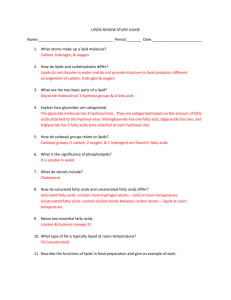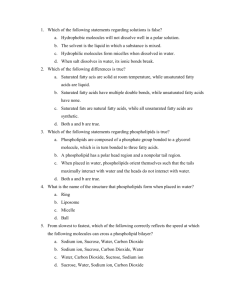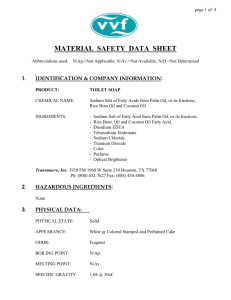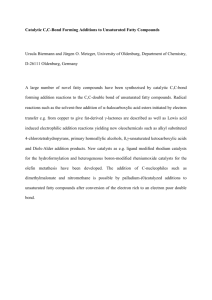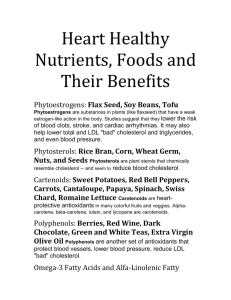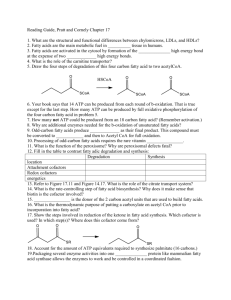Lipid Identification: Chemical Tests Lab Protocol
advertisement
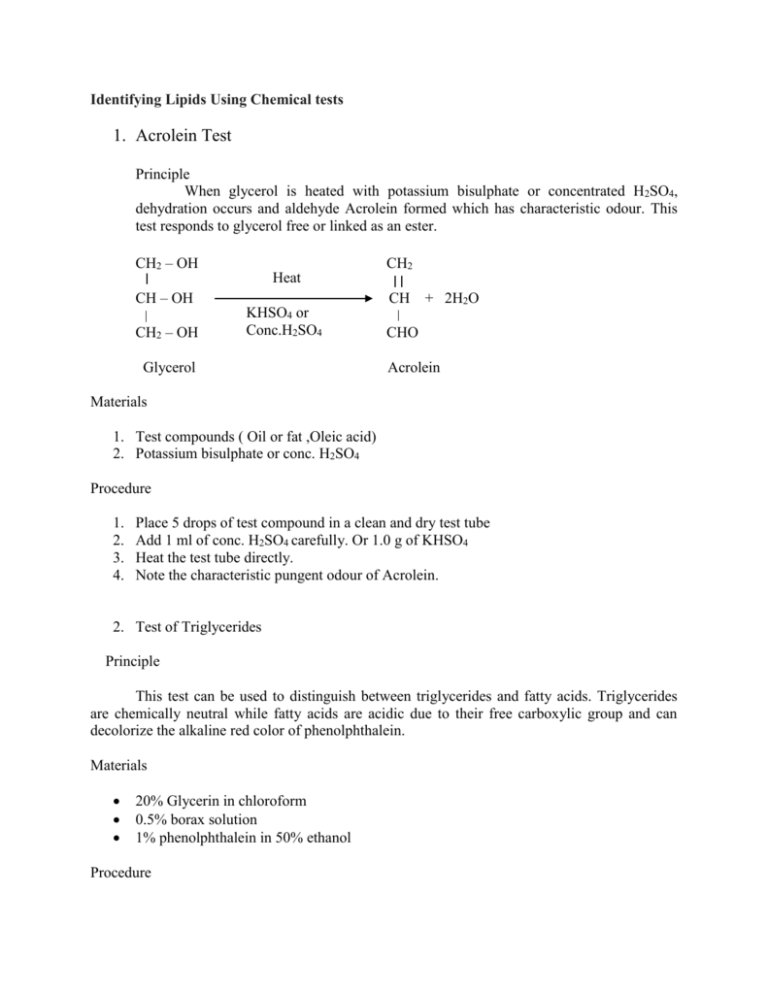
Identifying Lipids Using Chemical tests 1. Acrolein Test Principle When glycerol is heated with potassium bisulphate or concentrated H2SO4, dehydration occurs and aldehyde Acrolein formed which has characteristic odour. This test responds to glycerol free or linked as an ester. CH2 – OH CH2 Heat CH – OH CH2 – OH CH KHSO4 or Conc.H2SO4 Glycerol + 2H2O CHO Acrolein Materials 1. Test compounds ( Oil or fat ,Oleic acid) 2. Potassium bisulphate or conc. H2SO4 Procedure 1. 2. 3. 4. Place 5 drops of test compound in a clean and dry test tube Add 1 ml of conc. H2SO4 carefully. Or 1.0 g of KHSO4 Heat the test tube directly. Note the characteristic pungent odour of Acrolein. 2. Test of Triglycerides Principle This test can be used to distinguish between triglycerides and fatty acids. Triglycerides are chemically neutral while fatty acids are acidic due to their free carboxylic group and can decolorize the alkaline red color of phenolphthalein. Materials 20% Glycerin in chloroform 0.5% borax solution 1% phenolphthalein in 50% ethanol Procedure 1. 2. 3. 4. 5. Place 5ml of Borax solution (0.5%) in test tube Add appropriate volume of Phenolphthalein till red color is appearing. Add 20% glycerin drop by drop till red color is disappearing. warm the test tube, the red color will appear again. fatty acids are not responding to this test. 3. Test of cupric acetate for detecting fatty acids This test is used for detecting saturated and unsaturated fatty acids, fatty acids reacts with cupric acetate to form cupric salts of fatty acids. The cupric salts of saturated fatty acids are not dissolved in water or petroleum ether; therefore, it’s precipitated at the bottom of test tube. The cupric salts of unsaturated fatty acids are dissolved in petroleum ether with blue-green color. Materials Saturated fatty acid ( stearic acid or palmitic acid) Unsaturated fatty acid ( Oleic acid) 10% aqueous cupric acetate Petroleum ether Procedure 1. Dissolve small mount of fatty acid in petroleum ether. 2. Add appropriate amount of aqueous cupric acetate solution. 3. Shake the test tube carefully and observe green precipitate is appear at lower aqueous layer ( cupric acetate layer) where this is happened with saturated fatty acids while at upper organic layer ( petroleum ether layer) , blue or green color is appear when unsaturated fatty acid is used. 4. Test for the Degree of Unsaturation of Fatty Acids (Iodine test) Fatty acids in animal fats are usually saturated, whereas those in vegetable oils are generally unsaturated. Halogens ( I, Br ) will add across the double bonds and thus the decolorization of an iodine or bromine solution will indicate the presence of unsaturated fatty acids. Iodine test is used for distinguish between saturated and unsaturated fatty acids as well as between oils and fats. Materials 1. Oil, fat or oleic and stearic acids. 2. Organic solvents (chloroform or ethanol) 3. Hubl’s reagent ( alcoholic solution of iodine which contains some mercuric chloride) Procedure 1. Dissolve small amount of unsaturated fatty acid (Oleic acid) in small volume of chloroform. 2. Add Hubl’s reagent drop by drop and shaking the tube after each addition. The halogen solution should be added just until it fails to be decolorized. 3. Record the number of drops needed to bring about full decolorization. 4. Repeat the same procedure but by using saturated fatty acid ( stearic acid) and Compare your results. 5. Rancidity Rancidity is a process which is accompanied by the formation of unpleasant odour, taste, as a result of the action of moisture, air (O2) and enzymes.To guard against rancidity, we have to protect lipid from moisture and direct light as well as its storage must be in a cold place to deactivate lipase. Types of rancidity: 1- Hydrolytic rancidity (or lipolytic rancidity) 2- Oxidative rancidity Kreis-Kerr test Reagent: 1% of Phloroglucinol in alcohol or ether. Procedure 1 ml of rancid Oil is mixed with 1 ml of conc. HCl and then add 2 ml of 1% of Phloroglucinol , Shake and leave to stand for one hour. Appearance of red colour indicates the presence of aldehydes. The color intensity is increased with the increasing in the degree of rancidity in lipid. 6. Saponification of Fats and Oils Oils can be saponified with alkali soda to form soap and glycerol and it’s as follows: O H2 C O C O R HC O C O R H2 C O C R H2 C OH O + 3 KOH HC OH H2 C OH + 3R C OK Materials Oil Alcoholic sodium or potassium hydroxides(0.5 N) Sodium Chloride Concentrated hydrochloric acid Procedure 1. Place 5 g of oil or fat, 1.0 g of sodium hydroxide and 25 ml of alcohol in round flask. 2. Place the boiling stone at round flask for regulating the heating and reflux the solution for 30 minutes at boiling water bath. 3. Warm the solution for evaporating the alcohol. 4. Cool the solution in a beaker of cold water. 5. Remove a small piece of the solid product (about the size of a pea) using a glass stirring rod and dissolve it with 20 ml DW and observe the foam formed between soap and water. 7. Ammonium Molybdate Test for Phosphate The presence of free phosphate in acidic solution can be detected by adding a molybdate to the solution. Equation illustrates the pertinent reaction between phosphate and ammonium molybdate solution in the presence of nitric acid (HNO3). HPO42–(aq) + 12MoO42–(aq) + 3 NH4+(aq) + 23 H3O+(aq) (NH4)3[P(Mo3O10)4] (yellow,s) + 35 H2O(l) After a few minutes, the yellow ammonium molybdo-phosphate precipitates from the reaction mixture. When lipids containing phosphate groups in their structures are added to a strong acid solution such as the solution used here, the lipid hydrolyses, producing free phosphate. The free phosphate then reacts as in Equation, forming a yellow precipitate. Materials 1. Prepare an ice-water bath 2. Place 0.2 g of lecithin (ege yolk) in a washed , drained test tube 3. Add 3 ml of 6M nitric acid solution (HNO3). 4. Stir the reaction mixture by clean glass stirring rod. 5. Place the test tube containing the reaction mixture in ice-water bath for 5-10 mins. 6. Decant the clear solution into cleaned, drained test tube and add to it 1m of 0.2 M ammonium molybdate solution and mix the reaction mixture using a clean glass stirring rod. 7. Place the test tube containing the reaction mixture into a 65 ͦ C water bath for approximately 5 minutes. 8. Formation of yellow precipitate is observed due to existence of phosphate. 9. Record the observations. 8. Tests of Cholesterol Liebermann–Burchard Test for Cholesterol This test is used in the estimation of blood cholesterol.Cholesterol produces a characteristic green color when it is mixed with the Liebermann–Burchard reagent, a mixture of acetic anhydride and sulfuric acid. The change in color may be gradual, initially pink, then blue-purple, and finally deep green. Material 0.5 % cholesterol in chloroform Acetic anhydride Concentrated H2SO4 Procedure 1. 2. 3. 4. Place 1ml of 0.5 % cholesterol in chloroform in a dry test tube. Add 5 drops of acetic anhydride. Add 1 drop of conc. H2SO4 and mix. Observe the appearance of pink color which gradually turns into deep green. Salkowski test for cholesterol Material 0.5 % cholesterol in chloroform Concentrated H2SO4 Procedure 1. Place 1ml of 0.5 % cholesterol in chloroform in a dry test tube. 2. Add 1 ml of conc. H2SO4 3. Mix carefully and allow to stand and separate two layers , note the red color of the upper layer (chloroform) and green fluorescence in the lower layer. Zak test for cholesterol This test is used for determination of cholesterol in blood Material 0.2 g cholesterol in 1ml of conc. acetic acid Ferric chloride Conc. Acetic acid Conc. Sulfuric acid Procedure 1. Place 0.5 ml of prepared cholesterol solution in a dry test tube. 2. Add 2 ml of colored solution ( mixture of 10% ferric chloride , Conc. CH3COOH and Conc. H2SO4) 3. Observe appearance deep red which refers to existence of cholesterol



